For this reason, I wanted to do a close analysis of the beauty pageant scene, breaking it down shot by shot in order to discuss what Forman is doing here. My starting and ending points within the scene are fairly arbitrary: I start after the first contestant runs off, sparking the riot, and cut off slightly before the sequence's true end when the firemen hear the siren going off in the midst of the disorder. In between is one of the film's most rapidly edited and frantically paced sections, a masterpiece of madcap comedy where everyone looks like they're having a blast just filming it. I've broken this down by taking a single screen capture from each shot in this segment, in order to illustrate the ways in which Forman's seemingly unhinged depiction of the chaos at this party is actually built up from a meticulous sense of editing rhythms and an eye for striking compositions even within a frenzied environment.
The first shot of this sequence is a cut back to the main room after a (very funny) brief scene upstairs, where one of the committee members was attempting, in vain, to catch two of the contestants as they fled into the ladies' room. This shot introduces the more frenzied section of the scene, as the main ballroom degenerates into total chaos and the guys attempt to drag girls kicking and screaming onto the stage for the beauty contest. I've only selected one screen capture per shot here to keep this from being too long a post, but each of these individual shots changes quite a lot from one frame to the next, with the camera frequently swinging along to follow the actors in their rapid motion. These shots seldom settle into static compositions, but I think even these single frame grabs provide a sense of the movement and energy of this scene.

In contrast to the chaos of the party itself, the periodic shots of the announcers on stage are very static and stylized. Throughout the film, Forman maintains a rigid distinction between the way he films the brigade leadership (who represent the Politburo) and the people at the party (the proletariat). As in this shot, the committee members are inevitably presented with a somewhat distanced, formal quality that makes them seem especially absurd in the context of all the disorder surrounding them. Throughout this scene, in particular, the periodic shots of the announcers are islands of stability in a shifting sea. But this stasis does not have a positive connotation in any way. They are static, not because they are stable, but because they are helpless, paralyzed by the complete loss of control over what's happening. Forman is much more sympathetic to the wild partygoers who embrace anarchy as a response to their inept leaders; even if he sees this chaos as another symptom of a system out of control, Forman understands the urge to disorder when faced with such incompetently managed order.
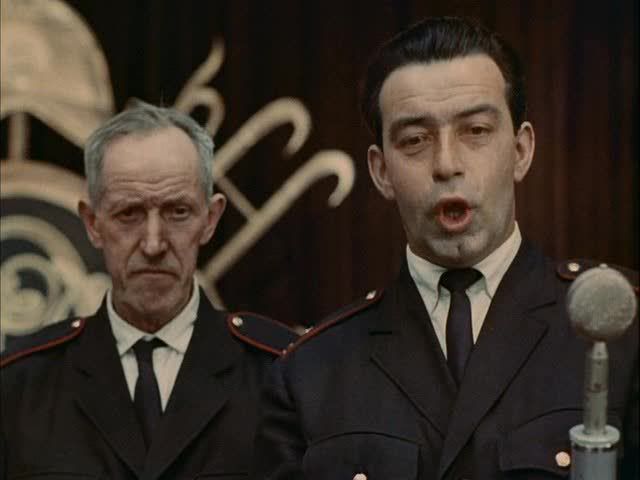
One of the characteristic features of this sequence, and the film as a whole, is the way that Forman frequently breaks down the body in shots that emphasize human movement and the awkward, messy exigencies of body-on-body contact in tight spaces. In this case, of course, the tight space is mainly the constriction of Forman's own frames, which are usually surrounding quite a few people. The next four shots are briskly edited together with lots of camera movement, as well as people moving very quickly within the shot. These shots are also mostly focused below the waist, with legs figuring in very heavily. Forman seems to have a fascination with women's legs that goes beyond mere sexualization. The focus on legs here is linked with the sequence's locomotive sensation, honing in on straining leg muscles and legs in various positions of flight and maneuvering. The scene might even be read, with some admitted stretching, in proto-feminist terms, whereby the legs that men viewed as sexual objects (the committee members got down to ground level in an earlier scene to check out the gams of prospective contestants) now become the means of flight from a demeaning beauty contest.

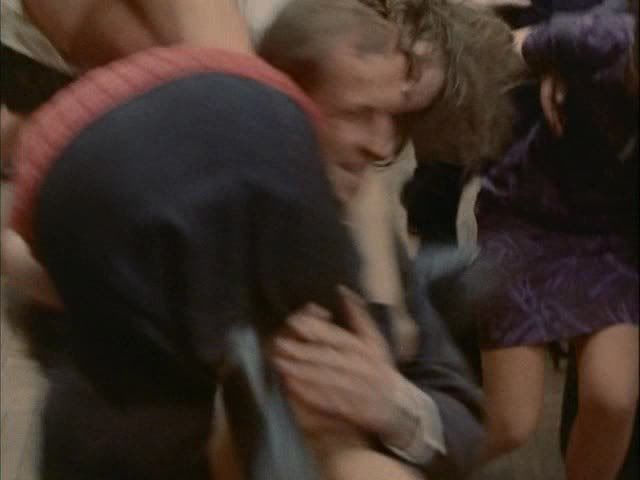
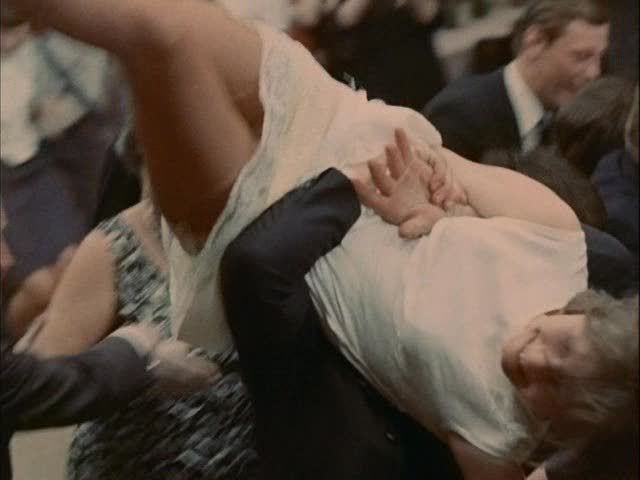

The next shot cuts back to the face of the one contestant who is actually standing on stage at this point, the first girl to go up, not because she was particularly bold or untroubled by the process, but because her father literally pushed her into it. These periodic cuts to the stage throughout this scene are moments of stasis, providing a contrast against the rowdiness of the crowd. This stasis is fleeting, though. As the scene goes by, the stage becomes less and less reliable as a source of safety from the rioting masses: the one contestant on stage makes her own flight from the pageant, the announcers finally give up and sit down, leaving the crown on the ground, and finally the rioters themselves take the stage, crowning one of their own in a triumphant end to the festivities.
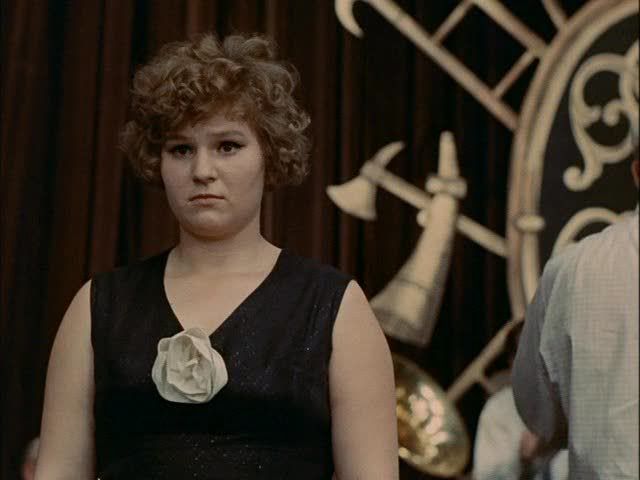
Forman next cuts back to the crowd, with a long shot of a group of guys lifting a laughing girl up onto a chair, followed by another close shot that emphasizes a woman's legs as she's carried around somewhat awkwardly.
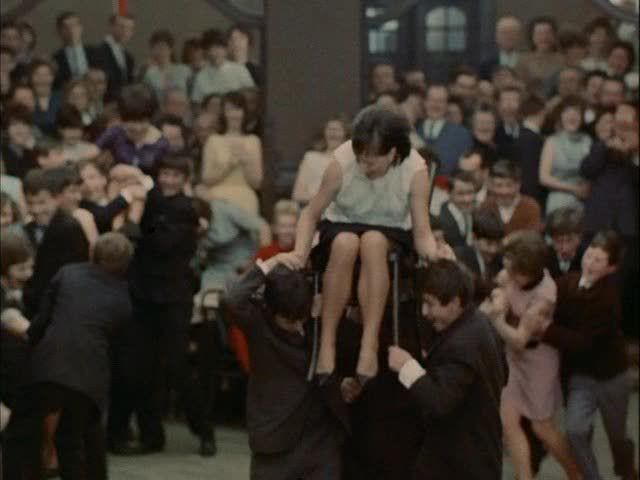
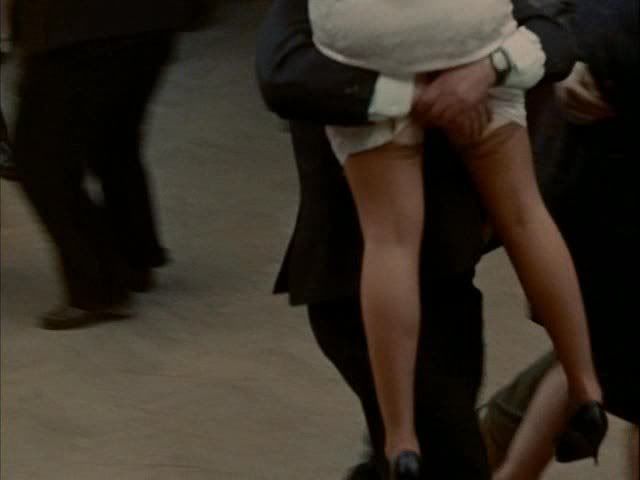
The camera cuts back to the increasingly frustrated announcers, who by now are getting tired of holding the crown aloft awaiting its recipients, and who are on the verge of giving up for good. The slightly low angle of these shots, and the grandiose decorations on the stage behind them, sets up these figures as sources of authority, clearly placed on a higher plane than the audience. The joke is that their supposed authority turns out to be empty flourishes, as the contestants refuse to obey them in coming up on stage, and they can't even get the band behind them to keep playing without taking a break for beer — an unfortunate pause in the music that unfortunately gave the contestants just the excuse they needed to break loose in the first place. This brief shot of authority collapsing into acquiescence is followed by another of the scene's characteristic shots of men and women scuffling in the crowd. These shots are taken from ground level, keeping them at the level of the rioters' legs, thus signaling the disparity between the higher authorities and the common people below them. In this particular shot, the two people in the foreground briefly clench, then come apart as the woman pushes the man to the floor, the camera shaking slightly downward, cutting off her head and focusing more on her legs as the man's fall is completed.
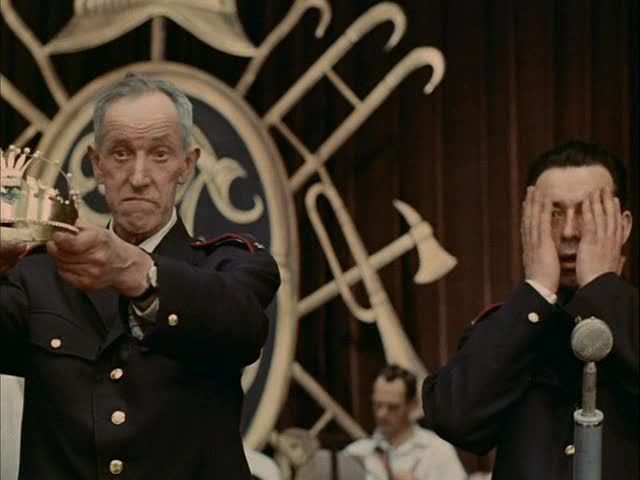
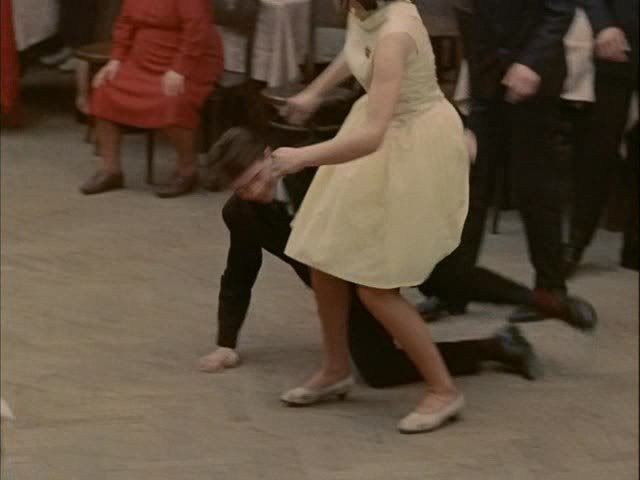
Forman's attention to legs is at times matched by the impression he gives of a sea of anonymous heads forming a monolithic crowd. Part of the film's critique of collective action is the way it captures the loss of individual identity in large masses, and the crowd scenes frequently point out and comment on this anti-individualist aspect of groups. It's easy to see this de-individualization in the many shots of legs, feet, and torsos, disconnected from their owners, but Forman's critique is every bit as implicit in the shots that show heads and faces. Even in these shots, individual people are given only fleeting representation, their faces glimpsed momentarily and then lost in the sea of undifferentiated bodies around them. Forman's frame is frequently obscured here by cloudbursts of frizzy hair and blurry, indistinct outlines of the revellers' heads. The occasional recognizable individual, like the laughing girl in the second shot below, seem to be peering out at the camera from a great distance, lost in the swirling, non-stop motion of her surrounding comrades.


Another subtextual undercurrent in this scene is the way in which Forman treats parts of the female body usually associated with sexualized depictions, especially when they're emphasized as much as they are here. In another film, it would be hard to view an extreme closeup of a woman's butt as anything other than the most blatant of sexual exploitation on the part of the director. Forman's perspective seems to be quite distinct from this crudely sexual viewpoint. Throughout the film he points out the sexualization of women's bodies in wry, ironical ways, not at all sympathizing with the leering gazes of the firemen but instead pointing out their objectification. During the scenes where the committee members are picking their contestants, Forman continually mocks the ways in which these ridiculous men size up the women like cattle. There's a hilarious scene where the men can't decide which part of the women's bodies to look at, so they first circle the ballroom ostentatiously staring at the girls' faces, then they go up on a balcony to check out bust sizes and cleavage, and finally they're crawling around on all fours at leg level. This tendency to ridicule the men for their libidinous gaze is carried over into the scene where they make the women line up in formation, barking orders at them, and finally make them march in circles. During this drill-like pageant preparation, Forman's camera drifts down to chest level, focusing on the breasts of the women as they circle in front of the camera's stationary position. This camera placement isn't meant to give the audience any gratification, but to draw attention to the perspective of the men who are watching this spectacle; Forman simply shows us what they're seeing.
The similar shots in the context of the riot scene are not as obviously satirical — there is no observing male viewpoint for Forman to mock in this case — but they nevertheless serve a similar purpose by drawing attention to the way that the men attempt to violently, forcefully round up the women for the pageant, as though they're herding animals rather than recruiting contestants. The focus on the women's physicality, as they gleefully avoid capture, thus emphasizes the parts of their bodies that invite male attention, while simultaneously subverting this attention with the overall thrust of the scene.

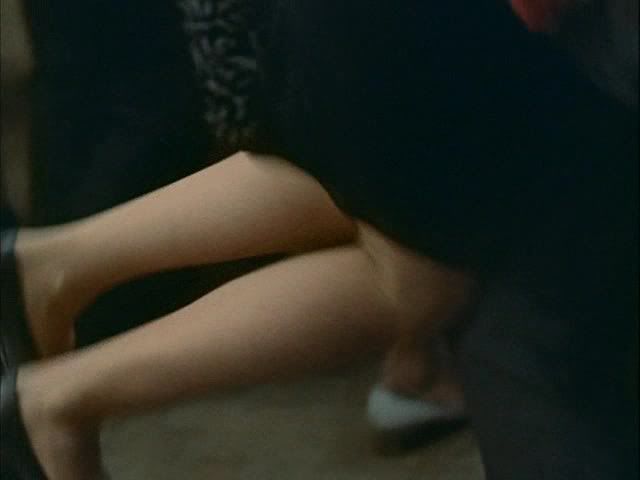
Continue reading this article with Part 2.





2 comments:
One striking thing to take away from this scene is how truly divorced the committee members are from the women as sexual beings. Absurdly, they are shown examining a photo of Western beauty pageant contestants to figure out what they should be looking for. They don't come anywhere near to choosing the most beautiful girls in the room--the Communist dogma of all people being comrades is both liberating for women in terms of job opportunities and desexualizing.
Forman's peep show returns part of a woman's sexuality to her (I was particularly taken with the woman whose skirt rides up, revealing her stocking garters), but defines it in terms of the male gaze, particularly since the men are pushing the women around.
Your discussion of body parts as opposed to whole beings suggests the abstraction of women in this community and doesn't approach the playful aggressiveness of a similar scene in New Waver Vera Chytilová's Daisies in which the main characters, a pair of sisters, cut each other with scissors, with special effects used to erase parts of the bodies and leave other parts floating freely. I was given the impression of chickens with their heads cut off by Forman's scene, as though the proletariat, because of its ineffectual leadership, cannot direct themselves. I think this film equally savages the proletariat and their learned helplessness. But Forman gives them back a measure of their humanity in the fire scene, where their faces glow with compassion in Rembrandtesque compositions. But as soon as the revellers return to the ballroom and the auspices of the committee, they return to their more base instincts by thieving and offering mock charity to the man who lost his home.
I think it's interesting that Forman dealt with competition in his Czech films. He understands, I think, the merits of free enterprise and how perverted they are in a socialist society. In his first film, Competition, brass band members are dismissed for being lazy, only to switch bands and be welcomed with open arms. Girls trying out for a musical revue must bear the scrutiny of a panel of judges, but at least they are there of their own volition. in The Firemen's Ball the competitors have no internal incentive (nor should they) to risk public humiliation.
Very good points, Marilyn. The treatment of bodies in this scene is very interesting, and the way Forman breaks down the bodies of the women in the audience into their constituent parts suggests the profound disconnect from sexuality that's going on here. This may be even more obvious in the second half of my analysis, which will feature the woman you mention with the garters -- a startling, wonderful moment -- and the crowning of a very unexpected contest winner.
Post a Comment